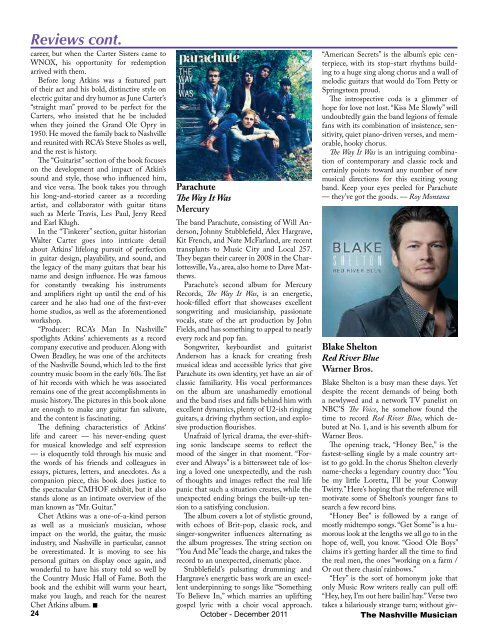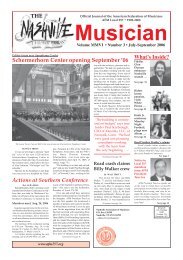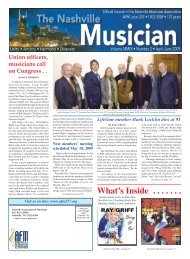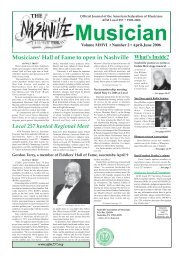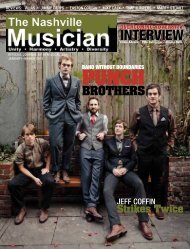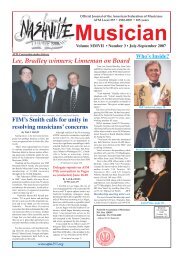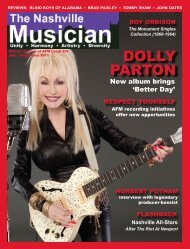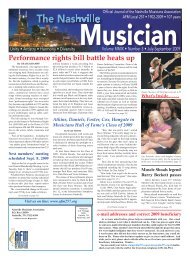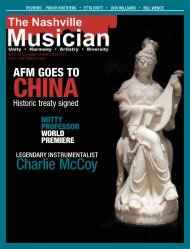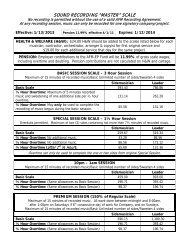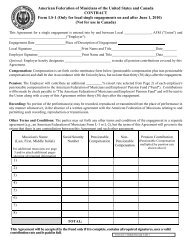BELA FLECK - Nashville Musicians Association
BELA FLECK - Nashville Musicians Association
BELA FLECK - Nashville Musicians Association
Create successful ePaper yourself
Turn your PDF publications into a flip-book with our unique Google optimized e-Paper software.
Reviews cont.<br />
career, but when the Carter Sisters came to<br />
WNOX, his opportunity for redemption<br />
arrived with them.<br />
Before long Atkins was a featured part<br />
of their act and his bold, distinctive style on<br />
electric guitar and dry humor as June Carter’s<br />
“straight man” proved to be perfect for the<br />
Carters, who insisted that he be included<br />
when they joined the Grand Ole Opry in<br />
1950. He moved the family back to <strong>Nashville</strong><br />
and reunited with RCA’s Steve Sholes as well,<br />
and the rest is history.<br />
The “Guitarist” section of the book focuses<br />
on the development and impact of Atkin’s<br />
sound and style, those who influenced him,<br />
and vice versa. The book takes you through<br />
his long-and-storied career as a recording<br />
artist, and collaborator with guitar titans<br />
such as Merle Travis, Les Paul, Jerry Reed<br />
and Earl Klugh.<br />
In the “Tinkerer” section, guitar historian<br />
Walter Carter goes into intricate detail<br />
about Atkins’ lifelong pursuit of perfection<br />
in guitar design, playability, and sound, and<br />
the legacy of the many guitars that bear his<br />
name and design influence. He was famous<br />
for constantly tweaking his instruments<br />
and amplifiers right up until the end of his<br />
career and he also had one of the first-ever<br />
home studios, as well as the aforementioned<br />
workshop.<br />
“Producer: RCA’s Man In <strong>Nashville</strong>”<br />
spotlights Atkins’ achievements as a record<br />
company executive and producer. Along with<br />
Owen Bradley, he was one of the architects<br />
of the <strong>Nashville</strong> Sound, which led to the first<br />
country music boom in the early ’60s. The list<br />
of hit records with which he was associated<br />
remains one of the great accomplishments in<br />
music history. The pictures in this book alone<br />
are enough to make any guitar fan salivate,<br />
and the content is fascinating.<br />
The defining characteristics of Atkins‘<br />
life and career — his never-ending quest<br />
for musical knowledge and self expression<br />
— is eloquently told through his music and<br />
the words of his friends and colleagues in<br />
essays, pictures, letters, and anecdotes. As a<br />
companion piece, this book does justice to<br />
the spectacular CMHOF exhibit, but it also<br />
stands alone as an intimate overview of the<br />
man known as “Mr. Guitar.”<br />
Chet Atkins was a one-of-a-kind person<br />
as well as a musician’s musician, whose<br />
impact on the world, the guitar, the music<br />
industry, and <strong>Nashville</strong> in particular, cannot<br />
be overestimated. It is moving to see his<br />
personal guitars on display once again, and<br />
wonderful to have his story told so well by<br />
the Country Music Hall of Fame. Both the<br />
book and the exhibit will warm your heart,<br />
make you laugh, and reach for the nearest<br />
Chet Atkins album. n<br />
Parachute<br />
The Way It Was<br />
Mercury<br />
The band Parachute, consisting of Will Anderson,<br />
Johnny Stubblefield, Alex Hargrave,<br />
Kit French, and Nate McFarland, are recent<br />
transplants to Music City and Local 257.<br />
They began their career in 2008 in the Charlottesville,<br />
Va., area, also home to Dave Matthews.<br />
Parachute’s second album for Mercury<br />
Records, The Way It Was, is an energetic,<br />
hook-filled effort that showcases excellent<br />
songwriting and musicianship, passionate<br />
vocals, state of the art production by John<br />
Fields, and has something to appeal to nearly<br />
every rock and pop fan.<br />
Songwriter, keyboardist and guitarist<br />
Anderson has a knack for creating fresh<br />
musical ideas and accessible lyrics that give<br />
Parachute its own identity, yet have an air of<br />
classic familiarity. His vocal performances<br />
on the album are unashamedly emotional<br />
and the band rises and falls behind him with<br />
excellent dynamics, plenty of U2-ish ringing<br />
guitars, a driving rhythm section, and explosive<br />
production flourishes.<br />
Unafraid of lyrical drama, the ever-shifting<br />
sonic landscape seems to reflect the<br />
mood of the singer in that moment. “Forever<br />
and Always” is a bittersweet tale of losing<br />
a loved one unexpectedly, and the rush<br />
of thoughts and images reflect the real life<br />
panic that such a situation creates, while the<br />
unexpected ending brings the built-up tension<br />
to a satisfying conclusion.<br />
The album covers a lot of stylistic ground,<br />
with echoes of Brit-pop, classic rock, and<br />
singer-songwriter influences alternating as<br />
the album progresses. The string section on<br />
“You And Me” leads the charge, and takes the<br />
record to an unexpected, cinematic place.<br />
Stubblefield’s pulsating drumming and<br />
Hargrave’s energetic bass work are an excellent<br />
underpinning to songs like “Something<br />
To Believe In,” which marries an uplifting<br />
gospel lyric with a choir vocal approach.<br />
October - December 2011<br />
“American Secrets” is the album’s epic centerpiece,<br />
with its stop-start rhythms building<br />
to a huge sing along chorus and a wall of<br />
melodic guitars that would do Tom Petty or<br />
Springsteen proud.<br />
The introspective coda is a glimmer of<br />
hope for love not lost. “Kiss Me Slowly” will<br />
undoubtedly gain the band legions of female<br />
fans with its combination of insistence, sensitivity,<br />
quiet piano-driven verses, and memorable,<br />
hooky chorus.<br />
The Way It Was is an intriguing combination<br />
of contemporary and classic rock and<br />
certainly points toward any number of new<br />
musical directions for this exciting young<br />
band. Keep your eyes peeled for Parachute<br />
— they’ve got the goods. — Roy Montana<br />
Blake Shelton<br />
Red River Blue<br />
Warner Bros.<br />
Blake Shelton is a busy man these days. Yet<br />
despite the recent demands of being both<br />
a newlywed and a network TV panelist on<br />
NBC’S The Voice, he somehow found the<br />
time to record Red River Blue, which debuted<br />
at No. 1, and is his seventh album for<br />
Warner Bros.<br />
The opening track, “Honey Bee,” is the<br />
fastest-selling single by a male country artist<br />
to go gold. In the chorus Shelton cleverly<br />
name-checks a legendary country duo: “You<br />
be my little Loretta, I’ll be your Conway<br />
Twitty.” Here’s hoping that the reference will<br />
motivate some of Shelton’s younger fans to<br />
search a few record bins.<br />
“Honey Bee” is followed by a range of<br />
mostly midtempo songs. “Get Some” is a humorous<br />
look at the lengths we all go to in the<br />
hope of, well, you know. “Good Ole Boys”<br />
claims it’s getting harder all the time to find<br />
the real men, the ones “working on a farm /<br />
Or out there chasin’ rainbows.”<br />
“Hey” is the sort of homonym joke that<br />
only Music Row writers really can pull off:<br />
“Hey, hey, I’m out here bailin’ hay.” Verse two<br />
takes a hilariously strange turn; without giv-<br />
24 The <strong>Nashville</strong> Musician<br />
ing away too much, let’s just say that Shelton<br />
probably won’t be asked to perform this one<br />
for the Family Research Council. The bridge<br />
even quotes “I Am The Walrus” just for fun.<br />
The final track is the true heart and soul<br />
of this collection. “Red River Blue,” written<br />
by Ray Stephenson and Buddy Owens, is an<br />
absolute gem, a moving tale of heartache experienced<br />
by the stubbornly proud man who<br />
let the woman he loves slip away. The acoustic<br />
guitars of Bryan Sutton and Ilya Toshinsky<br />
— both Local 257 members — drive this<br />
one all the way. Producer Scott Hendricks<br />
wisely chooses to keep the intensity level low,<br />
letting the lyric — and Shelton’s delivery —<br />
do the emotional heavy lifting. It’s the kind<br />
of song <strong>Nashville</strong> does best, and it draws the<br />
album to a perfect close. — Kent Burnside<br />
Various Artists<br />
The Lost Notebooks of Hank William<br />
Egyptian Records/CMF Records/Columbia Records<br />
Ronnie Dunn<br />
Ronnie Dunn<br />
Sony <strong>Nashville</strong><br />
“Singer In A Cowboy Band,” the first track of<br />
Ronnie Dunn’s solo debut album, opens with<br />
a nasty tremolo guitar lick that explodes into<br />
a punk country roadhouse beat before setting<br />
up his familiar voice passionately belting out<br />
a lyric of a hard life spent on the road.<br />
Dunn’s distinctive vocals are front and<br />
center like never before, and are in top form<br />
throughout this self-produced project. The<br />
rockers are smoking, the ballads have an<br />
R&B edge that brings out the soulful side of<br />
Dunn’s voice, and his classic country growl<br />
is fine shape.<br />
The album credits reveal that 48 of <strong>Nashville</strong>’s<br />
finest players appear on this record, although<br />
individual songs are not specified, so<br />
it’s a bit difficult to know exactly who played<br />
on what. Regardless, the playing is consistently<br />
outstanding. Five acoustic guitar players,<br />
six bassists, and seven electric guitarists<br />
are listed, as well as dozens of other players<br />
and singers, including strings beautifully orchestrated<br />
by Bergen White.<br />
Nine of the 12 songs were written or cowritten<br />
by Dunn, and most celebrate work-<br />
The <strong>Nashville</strong> Musician October - December 2011<br />
There are many questions concerning<br />
the appropriateness of the new<br />
tribute album, The Lost Notebooks of<br />
Hank Williams, in which a variety of singersongwriters<br />
added melodies, and in some cases<br />
lyrics, to unpublished Hank Williams songs.<br />
Those questions were underscored when<br />
Williams’ grandson, AFM 257 member and<br />
recording artist Hank Williams III, revealed<br />
he was not asked to participate in the project.<br />
But putting all those questions of propriety<br />
aside, there can be no argument of the artistic<br />
credibility of the record.<br />
The album is the brainchild of veteran A&R<br />
executive Mary Martin. Martin originally<br />
envisioned it as a project for Bob Dylan, who has always cited the influence of Williams<br />
on his own music, and unquestionably a full-length album of material cowritten by two<br />
of the most influential songwriters in the history of popular music would have generated<br />
enormous interest. But Dylan thought additional artists should be involved, so they brought<br />
12 other singer-songwriters on board who count Williams among their influences — not<br />
only country artists, but also artists from the pop and rock worlds, including Levon Helm,<br />
Lucinda Williams and Jack White. And although Hank III wasn’t asked to participate, one<br />
of Williams’ grandchildren, singer-songwriter Holly Williams, was among the contributors.<br />
The song she cowrote with her grandfather, “Blue Is My Heart,” features her father, Hank<br />
Williams Jr. on backing vocals.<br />
Williams’ words, and their transcendent energy, are what empower this collection. You<br />
can tell the artists approached the project with care, borrowing heavily from the Williams<br />
songbook, with a few twists and turns, in crafting their melodies and arrangements. The<br />
result is every track feels right, even the contributions by artists whose names leap out<br />
as possibly not being a good fit for the project — White, Norah Jones, Jakob Dylan and<br />
Sheryl Crow. It’s easy to imagine Williams himself singing any of the 12 tracks included<br />
on this remarkable collection.<br />
Alan Jackson’s collaboration, “You’ve Been Lonesome, Too,” kicks off the record and<br />
immediately establishes an authentic tone with a sparse arrangement — “just like Hank<br />
[would’ve] done it back in 1949,” as he explained in an interview with GAC — no piano<br />
or drums.<br />
Dylan’s cowrite, “The Love That Faded,” follows, and even though his accompaniment<br />
includes drums and piano, it continues the authentic vibe. His pained vocals, which suggest<br />
he himself has lived William’s expression of love past, are backed with an arrangement<br />
featuring a catchy, Cajun-flavored waltz groove.<br />
A number of 257 members contributed to this unique tribute album, including Jackson,<br />
Patty Loveless, and Vince Gill and Rodney Crowell, who both collaborated with the late<br />
legend on “I Hope You Shed A Millions Tears,” the only three-way cowrite on the record.<br />
Although it is often written, but rarely true, there is not a bad track on this album. Some<br />
tracks, however, reveal more than others. It is really not surprising that Loveless’ track,<br />
or other tracks by artists with <strong>Nashville</strong> connections, sound like Hank Williams songs.<br />
But Jones’ beautiful “How Many Times Have You Broken My Heart” is a complete and<br />
pleasant surprise because it shows what a great country artist she could be if she wanted.<br />
And Levon Helm not only nails his collaboration, “You’ll Never Again Be Mine,” but in<br />
the process, reminds us how much Williams’ songs informed the music of The Band.<br />
The album closes with a religious-themed track by Merle Haggard, “The Sermon On The<br />
Mount.” Like Dylan and Helm, Haggard is of the generation that felt the direct influence<br />
of Hank Williams — while he was still alive and performing and recording — and just like<br />
Dylan and Helm, he is able to reach within and find that place occupied by Williams in his<br />
own art. Haggard’s cowrite is a moving and fitting finale to a project that was inherently<br />
fraught with artistic risks and yet succeeded.<br />
— Daryl Sanders<br />
25


